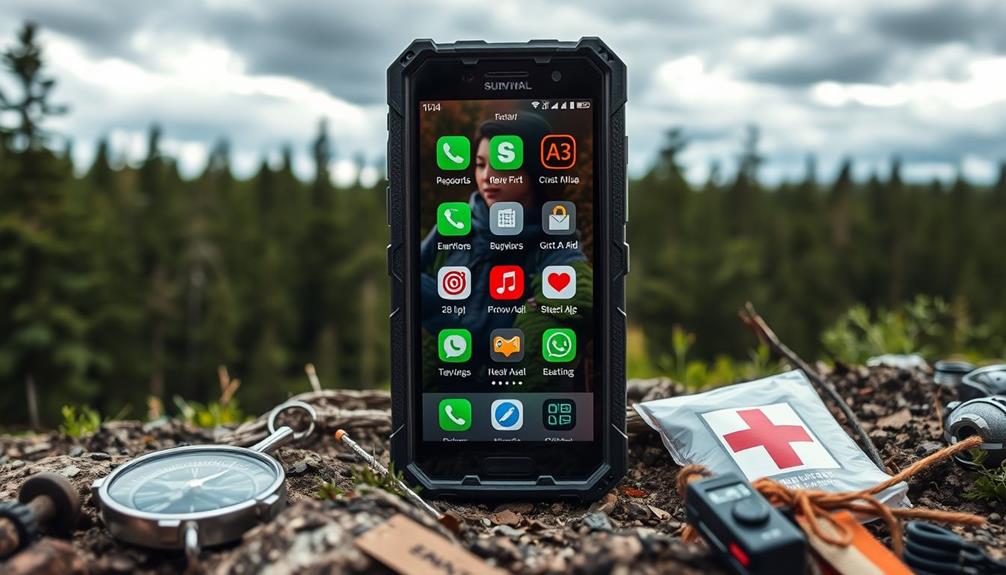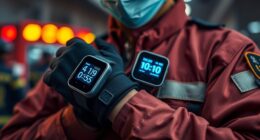To save lives during a power outage, you need to plan ahead. Keep backup power sources for critical medical devices, like portable batteries and generators. Regularly test these tools to guarantee they're operational when needed. Establish clear communication with your healthcare providers to manage medications, especially insulin, which needs careful temperature control. Conduct drills to prepare for emergencies and guarantee everyone's familiar with protocols. Maintain a list of emergency contacts and resources. With the right preparation, you can protect your loved ones during an outage and guarantee their medical needs are met effectively. There's more to explore on this topic!
Key Takeaways
- Ensure reliable backup power systems, including battery-powered devices and generators, to maintain continuity of medical care during outages.
- Regularly test and maintain emergency equipment to guarantee functionality when needed most.
- Conduct power outage drills to enhance staff preparedness and response capabilities in emergencies.
- Store medications like insulin properly and monitor temperature to prevent potency loss during power outages.
Importance of Emergency Planning
Emergency planning is vital for anyone relying on medical devices, as it can mean the difference between safety and a health crisis during power outages. If you depend on medical equipment like ventilators or oxygen concentrators, you need a solid plan in place.
Start by familiarizing yourself with the battery life of your devices and making sure you have access to emergency power sources. This means identifying backup power solutions, like generators or battery packs, that can keep your equipment running when the electricity goes out.
It's also important to maintain communication with your local utility companies about your power needs. Notify them about your reliance on medical equipment so they can prioritize your service during outages.
Regularly test and maintain your backup systems to confirm they're functional when needed. Additionally, keep a list of emergency contacts and essential instructions for your medical devices easily accessible.
Essential Backup Power Solutions

When it comes to ensuring your medical devices stay operational during an outage, exploring battery-powered options is essential.
You'll also want to keep generator safety in mind and have emergency charging solutions ready.
Let's look at how these strategies can help you maintain important care when power is compromised.
Battery-Powered Device Options
Battery-powered medical devices are essential for maintaining necessary care during power outages, guaranteeing patients receive uninterrupted treatment. You should consider having portable suction devices with battery backup, which can run for up to nine hours using alkaline batteries. This guarantees critical treatments continue even when the lights go out.
It's important to keep at least one bag valve mask per critical care patient ready for effective oxygenation during outages. Stock a variety of backup batteries, including both rechargeable and standard alkaline sizes, as many medical devices require specific types to function.
Regularly testing battery-powered emergency devices like defibrillators and infusion pumps is necessary; this confirms they're operational before you face a power loss.
Don't forget about portable power solutions. Rechargeable battery packs and solar-powered options can provide necessary backup energy for medical devices such as CPAP/BiPAP machines during extended outages.
Additionally, make sure you have emergency lighting ready to help navigate and manage care effectively in dark conditions. By preparing these battery-powered device options, you can help safeguard patient health when electricity is unavailable.
Generator Safety Tips
To guarantee safety during power outages, always operate generators outdoors in well-ventilated areas to prevent carbon monoxide poisoning.
Generators emit harmful gases, so keeping them away from living spaces is vital.
Confirm your generator is properly grounded and connected to appliances using heavy-duty extension cords to avoid electrical shock and protect your equipment.
Here are some essential generator safety tips:
- Test Regularly: Regularly test your generator to confirm it's operational and familiarize yourself with its fuel requirements and maintenance needs.
- Safe Fuel Storage: Store fuel for your generator in approved containers and away from living spaces to minimize fire hazards. Make sure to check local regulations regarding fuel storage.
Emergency Charging Solutions
Emergency charging solutions play an essential role in guaranteeing continuity of patient care during power outages, allowing essential medical devices to operate without interruption.
It's imperative to have a reliable backup power system in place, whether that's a generator or portable battery packs. Regularly test and maintain these backup power solutions to verify they're ready when you need them most.
Stock a variety of batteries, including rechargeable and standard alkaline sizes, to support devices like insulin pumps and oxygen concentrators. Alkaline batteries can provide around nine hours of operation for battery-operated devices such as portable suction units and manual resuscitation bags.
Additionally, consider investing in solar-powered options for critical medical devices, providing a sustainable energy source during prolonged outages.
If you or someone you care for relies on life-support equipment, don't forget to contact utility companies. Discussing priority reconnection services can help secure timely power restoration during emergencies.
With the right emergency charging solutions in place, you can maintain patient care continuity and guarantee that essential medical devices remain operational, even when the lights go out.
Device Testing and Maintenance

When it comes to device testing and maintenance, you can't overlook regular checks on all emergency equipment, including battery-powered devices.
Keeping detailed documentation of these maintenance activities guarantees everything's ready for use when you need it most.
Prioritizing high-risk equipment will help you provide the best care during power outages.
Regular Device Checks
Regular device checks are essential for guaranteeing that all critical medical equipment is ready to perform effectively during power outages.
By conducting routine assessments, you can assure the operational readiness of your emergency equipment and keep your patients safe. It's important to focus on the battery life of devices, as their functionality can be crucial in life-threatening situations.
Here are a few key checks to incorporate into your regular device checks:
- Daily inventory: Expand inventory checks of defibrillators and crash carts to include all emergency equipment.
- Scheduled tests: Regularly test portable suction devices and medication dispensers to confirm their working status.
Maintenance Documentation Practices
Maintaining thorough documentation of device testing and maintenance practices guarantees that all critical medical equipment functions properly during power outages. As a health care provider, you need a systematic approach to verify your emergency equipment is always ready. Regular checks on battery-powered devices enhance your preparedness.
Consider implementing a daily inventory check that covers all emergency equipment, not just the essentials like defibrillators. This proactive approach allows you to identify potential issues before an outage strikes. Additionally, scheduling tests for infusion pumps and other crucial devices verifies you can rely on their operational status when crises arise.
Here's a quick overview of essential maintenance documentation practices:
| Device Type | Testing Frequency |
|---|---|
| Battery-Powered Devices | Daily |
| Infusion Pumps | Weekly |
| Portable Suction Devices | Monthly |
| Medication Dispensers | Bi-Monthly |
Conducting Power Outage Drills

Conducting power outage drills is vital for guaranteeing you're prepared and can respond effectively during a real emergency. When the power goes out, every second counts, and having a plan can save lives. You should regularly practice these drills to enhance staff preparedness and improve efficiency under stress.
To make the most of your drills, consider the following:
- Collaborate with disaster preparedness teams to create realistic mock codes and scenarios.
- Familiarize all staff members with a written protocol for power loss situations.
Don't forget to keep a resuscitation bag handy during these drills, as it's essential for immediate medical interventions. Also, make sure that everyone knows how to use the equipment correctly.
After each drill, conduct a post-evaluation to identify areas for improvement. This way, you can integrate lessons learned into future preparedness plans.
Managing Medications and Insulin

During a power outage, managing medications and insulin becomes critical to safeguarding your health and well-being. Insulin needs to be stored between 36 to 46 degrees Fahrenheit for peak potency. If your refrigerator goes out, it can maintain that temperature for 2-3 hours if you keep the door closed. After that, consider using coolers with ice packs to keep your insulin cool, but avoid freezing it.
It's vital to monitor your insulin closely for any color changes or clumping; if it appears compromised, discard it. During a power outage, you should also closely monitor your blood glucose levels. Adjust your insulin administration plan if you can't refrigerate your supplies.
Don't forget to talk with your healthcare providers about alternative strategies for managing medications. They can provide valuable insights on what to do in prolonged outages and may suggest additional supplies you might need.
Preparing ahead can make all the difference in maintaining your health during unexpected events. By having a clear plan in place, you can navigate these challenges effectively and safeguard your well-being even when the lights go out.
Communication With Healthcare Providers

Effective communication with your healthcare providers is essential for ensuring uninterrupted medical care during power outages. Before an outage occurs, establish a clear line of communication to discuss emergency plans, including backup strategies for your medical devices. This proactive approach helps you stay prepared and connected when you need it most.
Here are some steps you can take to enhance communication:
- Keep a list of emergency contacts, including healthcare providers and local health departments, easily accessible.
- Utilize telehealth services for consultations during outages, allowing for remote guidance without the need for in-person visits.
Resources for Emergency Preparedness

Preparing for emergencies means knowing where to find reliable resources that can help you manage your medical needs during power outages.
Start by visiting Ready.gov, which offers extensive guidelines on emergency preparedness, including how to create disaster plans and stock essential supplies for your medical equipment. The Federal Emergency Management Agency (FEMA) also provides training and resources tailored for healthcare providers, ensuring they're ready to respond effectively during crises.
Connect with your local utility company to stay informed about potential outages and restoration timelines.
Additionally, community health departments often have programs designed to assist individuals relying on medical devices, promoting resilience in your area.
Don't underestimate the value of online forums and support groups; they can offer insights and shared experiences that enhance your preparedness efforts.
Support for Vulnerable Individuals

Support for vulnerable individuals is vital, especially when you consider that millions depend on electricity for life-sustaining medical devices. If you or someone you know relies on these devices, it's important to plan ahead for power outages. Here are some key steps you can take:
- Communicate: Notify local fire and police stations about medical device needs for timely assistance during outages.
- Backup Power: Guarantee access to battery packs or alternative power sources for devices like insulin pumps and oxygen concentrators.
Evaluating and Improving Plans

Evaluating and improving emergency response plans guarantees that healthcare providers and patients are ready to face power outages with confidence. To achieve this, you should regularly conduct drills and simulations that help your staff stay on top of protocols and equipment.
It's crucial to document and review the testing and maintenance of critical medical devices, as this helps identify any gaps in preparedness.
Collaborate with other healthcare providers to develop tailored plans for patients reliant on electricity-dependent devices. Effective communication is key during outages, so keep those lines open.
Utilize feedback from recent power outages to update and improve your existing emergency plans, ensuring they're practical and relevant.
Don't forget to assess your inventory of backup power sources and medical supplies regularly. This includes ensuring you have extra batteries on hand for essential devices.
By taking these steps, you'll enhance your facility's ability to provide uninterrupted care during power outages, ultimately saving lives.
What are the essential medical care tips to survive during an outage?
When preparing for a potential outage, it’s important to have essential medical care tips in place. Stock up on medications, first aid supplies, and essentials like clean water and non-perishable foods. Stay informed and learn from top preppers netflix shows to gather insight on emergency preparedness and survival tactics.
Conclusion
When the lights go out, you can still shine a light on safety and preparedness. By planning ahead and implementing backup solutions, you're not just saving power; you're saving lives.
Regularly test your devices and practice drills to keep your skills sharp. Stay in touch with healthcare providers and guarantee vulnerable individuals have the support they need.
Remember, in the face of an outage, your preparedness can be the beacon of hope that guides others to safety.










